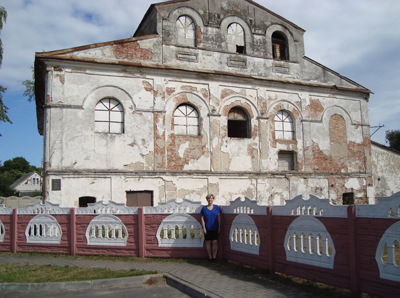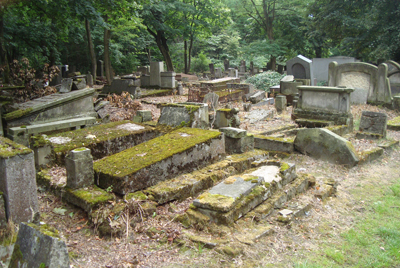In search of family history in Poland and Belarus
This article appears on page 32 of the February 2016 issue.
Among the cherished memories of our childhoods are the stories my wife, Judi, and I heard from our parents and grandparents about the towns and villages in Poland and Belarus that they came from. These good stories may have been at odds with the turbulent 19th- and early-20th-century history of those places that we had learned about in school, but they were, nonetheless, the stories of our families. Visiting those places became part of our post-retirement travel agenda.
On our way
Finally, in 2015, we decided to look into arranging a 10-day visit to Poland and Belarus. After evaluating several proposals, we chose Almatur of Opole, Poland, as our local travel agency.
Mr. Grzegorz Bartecki (phone +48 77 423 28 48, grzegorz.b@exciting poland.com) became our agent, and he expertly assisted us in developing our itinerary for the tour. He made all hotel arrangements for us, retained a guide/driver with a car, hired local guides in the various places on our itinerary and even assisted us in securing invitation letters from Belarus, which are obligatory for obtaining tourist visas, as Belarus is neither a member of the European Union nor a country that seems particularly eager to issue entry visas to individual travelers. We prevailed, allowing us to visit the birthplace of a paternal ancestor in Belarus.
We arrived in Warsaw on July 19 and were met at the airport by Mr. Witold Jablonski, who would be our guide/driver for the next 10 days. Mr. Jablonski (Vitek) turned out to be a resourceful, well-educated and pleasant young man with an excellent command of English and a profound knowledge of his country.
Vitek took care of every aspect of our journey with a pleasant attitude, including arranging dinners at wonderful restaurants offering plenty of vegetarian choices, which we prefer. Even then, it was difficult to resist the local delicacies and goodies that are customarily served with every meal.
Into Belarus
After visiting the impressive new Jewish museum in Warsaw and part of the city, we drove to Biała Podlaska, near the border with Belarus, and spent the night at the well-appointed Skala Hotel.
Before World War II, this regional capital was the home of a fairly large Jewish community to which only the cemetery and remnants of a former forced-labor camp bear witness today.
On the next day, we crossed the border into Belarus in an ordeal that took more than three hours of repeated checks of our vehicle, our baggage and our passports. It turned out to be well worth the effort when we reached the town of Kobryn, about 30 kilometers from the border, where part of our family had come from.
Guided in fluent English by our Belarus guide, we walked through the old Jewish neighborhood with its large-but-defunct synagogue and partially rehabilitated Jewish cemetery and were surprised that the area was larger than we had anticipated. We saw no traces of an active Jewish community.
We also found a modern pedestrian mall nearby leading to an attractively landscaped community plaza. We spent the night at the 5-star Hermitage Hotel in Brzes´c´ (Brest), a veritable showcase of old European elegance and style, particularly with regard to service.
Lublin
Crossing the border back to Poland, we drove through the many pretty, small towns of this affluent agricultural region of Poland on our way to Lublin, one of the country’s major business hubs. The Grand Hotel, where we stayed, lived up to its name, offering not only neat, modern accommodations and a convenient central location but a particularly good restaurant with superb service.
The Grand Hotel was located on the edge of the picturesque Old Town, the streets and alleys sloping down from an imposing old castle and moat high above the city.
The areas right below the castle, where Jewish merchants and their Christian neighbors once traded manufactured goods and agricultural produce in a common market and where their respective houses of worship once stood within sight of each other, have recently been transformed into tourist attractions, stores and parking lots.
Lublin seems to be enjoying a boom in European tourism and business opportunities. Its public areas were carefully maintained and inviting, and we found the Old Town and its perimeter to be good places for long walks.
Continuing to Kraków
Our initial impression, that Poland is a flat country brimming with wheat, corn and potato fields as far as the eye can see, gave way to a different one as we drove south toward Kraków, the country’s erstwhile capital in the days of the Habsburg Dynasty and its Austro-Hungarian Empire.
Kraków is situated in the foothills of the Tatra Mountains, and its narrow and winding streets follow the natural contours of the area. Kraków’s centerpiece is the 13th-century walled Old Town with its absolutely stunning public square, Rynek Glówny. One of the largest public squares in Europe, it is surrounded by colorful Baroque-style buildings and anchored by the beautiful St. Mary’s Basilica.
In the past 20 years, this square has been transformed into a pleasant outdoor space where locals and visitors can congregate to their hearts’ content, sip beer or coffee at any of the dozens of restaurants and cafés, window-shop at a wide variety of establishments or just enjoy the general ambience. Rynek Glówny is as vibrant as New York’s Time Square but without the incessant car traffic.
Kraków’s former Jewish quarter, called Kazimierz, was originally a separate city. It provided, arguably, the best reflection of the more than 800 years of Jewish presence in Poland. Besides several synagogues and community buildings of great historical importance, areas like Plac Nowy, the quarter’s main market square, were reminders of the daily life of the Jewish citizens who were once a very significant part of its cultural life.
A closer, documentary view of the past was presented in the very interesting exhibits of the Galicia Jewish Museum and the facilities of the former Schindler Factory, the latter the subject of the Spielberg movie “Schindler’s List.”
Although our hotel in Kraków was ideally located within the walls of the Old Town, Hotel Polski Pod Bialym Orlem turned out to be an unfortunate choice due to the unusually high summer temperatures and the hotel’s lack of air-conditioning. Opening the windows brought us little relief from the heat and a lot of street noise late into the night.
Mountain escape
We found relief from the summer heat a few days later in Zakopane, Poland’s main mountain resort town on the border with Slovakia. This resort was full of Polish vacationers who had come to climb the summits of the majestic Tatra Mountains and enjoy the so-called Highlander cuisine in the local restaurants as well as the entertainment provided by indigenous musicians and artists.
Aided by Vitek’s interpretations, we were simply delighted to be in the midst of it all and to enjoy the heartfelt hospitality.
The Nosalowy Dwór Hotel, on the outskirts of Zakopane, was a modern spa with a large swimming pool and an extensive fitness center. The traditional architecture of the hotel was in complete harmony with the surrounding mountains and forests, and the views from our room were breathtaking.
A long ride on excellent roads took us across the western countryside of Poland to Wrocław, the capital of Silesia, near the border with Germany. Like Kraków, Wrocław has a large public square (Rynek) with a Gothic church, but evidence of the destruction of many of its buildings during World War II was still clearly visible, despite ongoing reconstruction efforts.
It was particularly helpful to have a knowledgeable local guide to walk us through the city and provide a narrative link between the remnants of buildings and the history of this important city on the Odra River — the site of many battles.
Similarly, only traces remained of the former Jewish community there, like the renowned main synagogue, which now functions only as a museum.
Progress in rebuilding the city and its once-famous university was evident, and our accommodation, the sleek and comfortable Europeum Hotel, was very much part of the rebirth of Wrocław.
Łódz´
Łódz´ is Poland’s second-largest city and was an important industrial center at the start of the 20th century. It grew rapidly, attracting many people to its burgeoning commercial enterprises and factories, including many Jews from the surrounding villages searching for a better life. Large fortunes were made, and “Anything is possible in Łódz´” became a popular slogan throughout Poland.
Much of this rapid development of the early 20th century is still in evidence today in the enormous red-brick factory buildings and the exorbitant mansions of the former industrialists. Piotrkowska Street stretches for almost 5 kilometers straight through the center of the city, forming Łódz´’s commercial equivalent of London’s Oxford Street. Some former factory buildings have been turned into super-modern shopping malls and entertainment centers.
Even though only a handful of Jews remain in Łódz´, an interest in Jewish culture seems to thrive everywhere, with restaurants specializing in old Jewish cuisine and klezmer music concerts. Much to our amazement, young Poles confidently explained this phenomenon as recapturing some of the country’s lost traditions and culture.
On the other hand, the reality of the past is never hidden in this thriving metropolis, where the buildings and squares of the former Jewish ghetto and Europe’s largest Jewish cemetery have remained intact and accessible.
In Łódz´ we stayed at the Ambasador Hotel, which offered efficient service and modern conveniences but was located along a rather unattractive thoroughfare next to a shopping mall.
Łódz´ is a large and sprawling city which had a lot of construction detours, so getting around required a car, a skillful driver and, in our case, a knowledgeable local guide. We were fortunate to have all of them during our visit.
We wound up our history-and-heritage trip in Warsaw on July 29 with a final visit to the famous Warsaw Ghetto, well known for the Jewish uprising there in 1943. Warsaw is the only Polish city with a large functioning Jewish community and a synagogue that doubles as a community center and school.
We also walked through the streets of Stare Miasto, the Old Town, which are lined with Baroque and Renaissance-period burgher houses, and were astounded to learn from our guide that these authentic-looking houses were mere replicas of the former buildings. The originals were almost completely destroyed in World War II.
The realization that much of what visitors see as the history of Warsaw actually consists of replicas did not detract from the city’s rightfully regained status as a thriving modern European capital that is worth a visit.
The cost of our amazing history-and-heritage tour of Poland and Belarus was $2,970 per person, including all hotel accommodations, breakfasts and dinners, car and guide/driver, airport transfers and all admission fees.



